#Eastern Philosophy Influence
Text
“A high degree of intellect tends to make a man unsocial.”
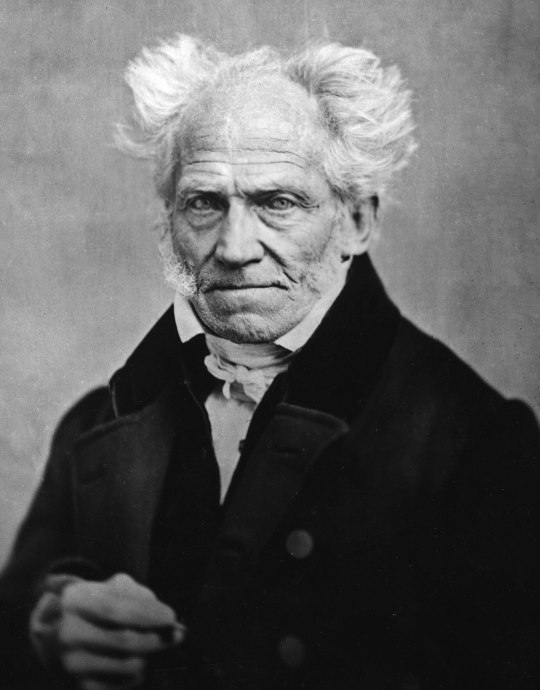
Arthur Schopenhauer was a German philosopher. He is best known for his 1818 work The World as Will and Representation.
#Pessimism#Will and Representation#Metaphysics#Ethics#Existentialism#Philosophy of Mind#Kantianism#Aesthetics#Solipsism#Nihilism#Idealism#Compassion#Individualism#World as Illusion#Transcendental Idealism#Suffering#The Fourfold Root of the Principle of Sufficient Reason#Eastern Philosophy Influence#Art and Beauty#Critique of Hegel's Philosophy#today on tumblr#quoteoftheday
25 notes
·
View notes
Text
Unveiling the African Essence in Eastern Philosophy
A Tribute during Black History MonthAs we embark on the celebration of Black History Month, it’s essential to recognize the myriad contributions of African descendants not just in shaping modern civilization but also in sculpting the contours of Eastern philosophy. The historical interweaving of African traditions with Eastern thought offers a rich narrative, highlighting a profound exchange of…

View On WordPress
#African influence#ancestral wisdom#ancient Egypt#Black History Month#Eastern Philosophy#Greek philosophy#Interconnectedness#nonduality#spiritual synergy#Transcendental Meditation#Ubuntu#Yoruba
6 notes
·
View notes
Note
i just watched someone saying "christianity is and always will be the cultural appropriation of religions" and they mentioned the resurrection, which surprises me a little. do you know what they could be referring to? they also called it a very common trope and i'm no theologian, don't know that much about other religions or mythology, so maybe you could help?
resurrection narratives are absolutely not unique to christianity. there are resurrection narratives in the religion of ancient egypt (osiris), greece (adonis, zagreus, dionysus, and attus), and sumer (dumuzid and inanna). all of these predate christianity by centuries. to consider resurrection myths appropriation is, however, rather ignorant: the mythologies of the ancient near east are absolutely woven together, to the point where they are almost indistinguishable from each other, especially in the early history of the hebrews. the roman empire was heavily influenced by hellenic culture, religion, and philosophy. consider dionysus, the god of wine: plutarch stated that the stories of osiris and dionysus were identical and that the secret rituals asociated with them were obviously paralleled: the second century AD saw the emergence of greco-egyptian pantheons where the god serapis was synonymous with osiris, hades, and dionysus. this is also similar to the interrelationship between inanna, ishtar, asherah, astarte, and multiple other near eastern female deities (and she likely played an influence in the development of lilith as well). how much did the cult of dionysus influence later rites of the wine and the eucharist in early christianity, especially given that within fifty years of christ's death most christians were greeks? romulus and remus were said to have been born to a virgin, and so was the founder of zoroastrianism, zoroaster, a religion that influenced platonic philosophy and all abrahamic faiths.
christianity is more guilty of appropriation that most other faith practices of appropriation because of the crudeness and hatefulness with which it borrowed judaism and then turned on the jews. but attempting to divide western and near eastern religious traditions into pure (original) and impure (appropriated) is next to impossible. otherwise we can start trying to particularize everything as either pure or impure and discard what we deem as "impure" or unoriginal because we think it is valueless, hackneyed, or unethical. religion does not work like that. christianity does require critical consumption and practice because it has both appropriated judaism and because the way in which it exerted itself as a dominant religion over other faith practices. and the appropriation of judaism must be especially viewed as troubling, because judaism cannot be compared, historically, to religions like those of ancient egypt and greece because until the state of israel it was never a dominant or state religion, and the fact that it survived some odd thousand years without being recognized as a state religion is part of why it's particularly interesting. of course, that has changed now, but this ask isn't about israel/palestine and i won't dwell on it this issue much except to reaffirm that christianity appropriating an oppressed minority religion that emerged out of colonial contexts is very different than christianity utilizing aspects of ancient greek religion or zoroastrianism, and also different from jesus being included in islam, for instance.
interestingly, quetzalcoatl, from the ancient aztec religion, was the patron of priests and a symbol of resurrection. this gestures to the hidden sacred, eliade's hierophany: the hidden holiness, the sacrality and beingness of something beyond ourselves, that underlies all existence, with its own explicit truths that emerge consistently in faith practices that, unlike those of the near east, never interacted. maybe we all carried the same stories out of the cradle of civilization; maybe there is a perpetual and accessible truth that transcends boundaries. i don't know. but everything is borrowed. everything is copy. humanity is not capable of true originality: and isn't that beautiful? everything is taken in communion. everyone is interconnected. everyone wants to believe something, and we seem to be universally compelled by the same truths, motifs, meanings, and stories.
72 notes
·
View notes
Note
along w ur plato post uve also mentioned disliking marxist syllabi that make you go chronologically just to understand one author (ie greek philo - hegel - marx)
i was planning to go down this route this yr to combine both my long overdue dive into theory and philosophy, and i actually found this to be less overwhelming than immediately diving into say, continental philosophy or critical theory. i wonder then what other route you'd suggest for philosophy? (since for marxist theory youve pretty much alr answered it in a past ask)
are greek philosophers still "useful" to read for beginners or is it much better off to start with contemporaries? is this a case of "we've actually been doing the math curriculum wrong this entire time" or is it just personal preference. help
depends what you're trying to accomplish, but if someone's in my inbox asking how to get started reading theory or philosophy then i think it's a) unhelpful, and b) needlessly deferent to received ideas of 'canonicity', to perpetuate the notion that there's a single correct order in which to read, and it begins with the same 20 ancient greeks writing about geometrical forms and elemental tetravalence. like, it's worth remembering what's missing from a typical global north university's philosophy syllabus: perhaps most obviously, reams of islamicate scholarship and centuries of dialogue between 'western' and 'eastern' writers often suppressed in favour of a 'dark ages' narrative that just sort of jumps up to the 'renaissance'... and there are so many other, egregious, historically unjustifiable lacunae like this.
it's noble enough to want to know where an idea comes from or what its genealogical lineage is, but to try to discover this by reading through a list drawn up by classicists or philosophy departments is dangerously optimistic about the politicking that shapes and perpetuates such lists. even just reading the works that an author is openly citing or arguing with is lacking: what about, say, hegel, whose idea of freedom and enslavement developed partially in response to reading newspaper coverage of the haitian revolution? he didn't exactly announce that in the text! to read the phenomenology of spirit as merely the next intellectual step after kant is deeply distorted; for that matter, kant's own intellectual influences came not only from a supposed philosophical canon but also from the scientific and anthropological discourses underpinning his biological theory of race and defence of racism.
my issue with the "read chronologically" approach isn't that it's bad to follow a topic over a process of historical change. it's that these received lists of 'canonical' thinkers are artefacts of their own social and historical contexts, and are both produced to certain ideological ends, & then appealed to later in order to enforce and even naturalise those ideologies. if what we want is the context to understand what hegel or marx or adorno were really talking about, we need to engage with the texts as historical documents and with the histories as products of imperfect, biased, and ideologically laden human labour.
i'm not here to tell you not to read whatever you were planning to read. for one thing, sometimes the intellectual influence named in the syllabus is a useful one (there are certain questions about marx and marxian ideas that are easier to understand and answer if you have read at least a little bit of hegel). but, in the context of the overwhelming gatekeeping of knowledge, and the hegemonic use of ideas about canonicity and the 'right' way to read 'classics', if someone asks what they need to do in order to read xyz, i'm pretty much never going to default to "start by reading plato". read things that are interesting to you, however old they are; read about their authors; make liberal use of online resources like the SEP if you need a crash-course on certain concepts or jargon. you certainly don't need to be afraid of reading one text to better understand another. i just don't think you need to be beholden to that mode of reading, either, especially not in a context where the common wisdom on whose work belongs in such a genealogy is predicated on centuries of colonial and imperial scholarship and disseminated by institutions structurally positioned to defend the idea of an enlightened and ennobling western intellectual tradition.
in a certain twisted way, these 'standard' (to whom?) or 'traditional' (since when?) reading lists are often presented as the shortcut to the 'correct' understanding of landmark texts or authors—only, this is a 'shortcut' that considers ideas as disembodied from their real contexts, relating only to one another in an intellectual realm and developing in more or less linear fashion often to some teleological end; and, by dint of the sheer amount of material involved, it's also a 'shortcut' that many people will never actually traverse. i don't have an inherent problem with reading chronologically. i just don't automatically defer to these kinds of syllabi, and i think dethroning them could do us all a lot of good.
87 notes
·
View notes
Text
Vedic Astrology Observations
Moon Dominant Men: “Deep and Mysterious”
🌖🌗🌘🌑🌒🌓🌔

(GIF context: Taken from Shadowhunters depicting a gay couple with Matt Daddario (left) who is Moon Dominant [Hasta sun and ketu with ketu as moon nakshatra ruler] and Harry Shum Jr. (right) who is Rahu Dominant [Ardra moon and Swati Jupiter with Sun in Jupiter ruled nakshatra]. Both actors identify as straight.)
In Vedic astrology, the Moon, or “Chandra”, occupies a position of profound significance. It is coveted as the very embodiment of the mind, a symbol resonant with clarity, reflection, instincts, and cycles, which when combined come to form what we know as perceptual consciousness. Like the Moon, which shines by reflecting the Sun's light, the mind similarly reflects its environment. It captures and reinterprets external stimuli, forming a consciousness that is, in essence, an image similar to that of a mirror of the surrounding world. In Vedic astrology, the Moon is a celestial body that stands as the fundamental indicator of one’s capacity for emotion and extends to one’s ability of cogitation, shaping the manner in which thoughts and emotions are processed and articulated. In contrast to Western philosophical perspectives, which tend to dichotomize emotions and logic, framing them as diametric to one another, Vedic astrology presents the Moon as a mediator that brings the two faculties together through upholding the position that our cognitive and decision-making processes are inextricably linked with emotional undercurrents. It echoes a sentiment that, even in endeavors that ostensibly try to prioritize objectivity, such as with epistemological pursuits, true objective knowledge is nothing but an elusive ideal. This stems from the notion that our perception forms our reality, encapsulated in the phrase, “I am my universe.” This is where the significance of the Moon in Vedic astrology becomes particularly relevant. It posits the idea that our subconscious greatly influences our conscious mind, thereby molding our individual perceptions of reality and shaping the way we experience the world. It recognizes the limitations in our control over our mental faculties and how emotions actively play a part in deciding our thoughts and life trajectories, whether we like it or not. This allows the symbolism of the Moon in Vedic astrology to effectively capture the human condition's amalgamation of thought and feeling, thereby speaking to the interaction of light and shadow in the psyche and the ongoing process of mental transformation.
Men with a pronounced lunar influence in their astrological charts, notably distinguished by those with primary placements (Sun, Moon, or Ascendant) in or aspects with Moon-ruled nakshatras such as Rohini, Hasta, and Shravana (planetary dominance can be determined in more subtle ways as well), present an intriguing study into the nuanced expressions of masculinity and relational dynamics. Examples of Public figures like Henry Cavill, with his Shravana Ascendant and Moon in the first house, or fictional characters like Flynn Ryder, voiced by an actor with a Hasta Sun and Rohini Moon, exemplify a unique blend of characteristics associated with lunar dominance that I will continue to explore further.
(GIF and image contexts: The first GIF shown depicts Henry Cavill as Clark Kent in Man of Steel. The second is an image showing the fictional character Flynn Ryder side by side with his voice actor Zachary Levi.)

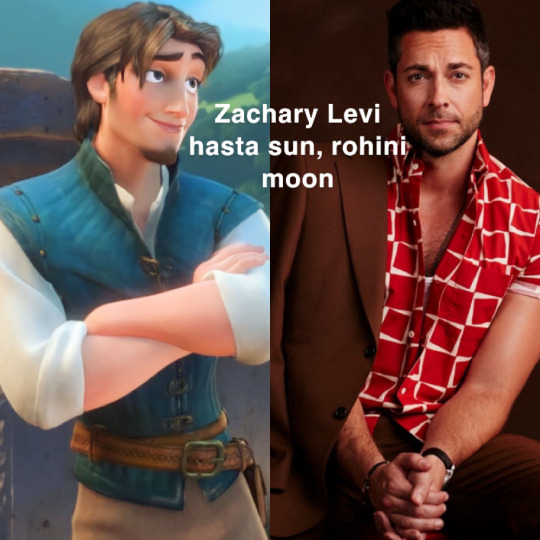
The influence of the Moon on men can be understood through the influence of the mother and the lens of "Yin and Yang" in Eastern philosophy. In Vedic astrology, the Moon's connection with the mother can be said to link the development and characteristics of individuals to the amount of nurture and emotional sustenance they were provided with as a child. This nurturing shapes the robusticity of their intrinsic Yin qualities – receptivity, passivity, intuition, and a deep connection with the maternal aspects of life, often linked to the feminine. These qualities are further symbolized by the Moon and its cycles, traditionally associated with menstruation, highlighting the cyclical and nurturing features of femininity. In contrast, Yang represents the dynamic, assertive, and outward energy projection, typically linked to the masculine and more solar sattvic energies. Men with Moon-dominance in their astrological profiles embody this Yin energy, exemplifying a reflective masculinity and an inward understanding of femininity. This inward orientation of Yin, shaped significantly by the emotional and nurturing bond with mother figures, provides these men with a deeper understanding and connection to various feminine aspects of life. At the same time, the outward orientation of Yang allows for an external connection to the masculine, producing a self-identified masculinity that is introspective and emotionally/mentally attuned to the feminine while still being confident in its own nature. This ultimately does have a dampening effect on their exhibition of traditionally masculine behaviors, being that men as a whole are ruled by the Sun and are said to be more solar, while women as a whole are ruled by the Moon and are said to be more lunar. (The 24-hour circadian rhythm is based on the male hormone cycle and aligns with the Earth's orbit relative to the sun, while women have what is known as an infradian rhythm, which follows the 28-day lunar cycle, for reference). This internal emphasis on Yin but external reflection of Yang in Moon-dominant men's personalities makes them emotionally rich and empathetic, displaying a unique blend of masculine and feminine energies that is both introspective and in harmony with the external world. The Moon serves to harmonize the intense energy of the Sun, offering calming and nurturing attributes, ultimately leading to the formation of a kind of masculinity in these men that is fluid and can express strength in gentleness and assertiveness in sensitivity. However, this can also make them uniquely susceptible to certain challenges, which I will continue to discuss further in the following paragraphs.
The Moon is also tied with its nodes: Rahu and Ketu, the two mathematical points where the Moon's orbit meets the ecliptic (if you didn’t know, the Moon does not directly follow the ecliptic itself, which is the sun's path in the sky; it’s about 5° off approaching either node). The Moon's astrological significance is intricately linked to Rahu and Ketu, with all three governing distinct facets of consciousness. Rahu, often depicted as the head of a dragon or the head without a body, symbolizes material desires and is associated with the future, representing the qualities we need to develop and the experiences we must have to grow. Rahu is primarily concerned with the rational mind and the projection of consciousness into the material realm, epitomizing ambition, desire, and worldly aspirations. It represents the part of the psyche that is outwardly focused, engaging with the tangible aspects of life that are said to paradoxically represent the illusion of Maya. Conversely, Ketu, commonly depicted as the dragon’s tail or a headless body, represents detachment, spirituality, and the internal journey. It is associated with the past and karmic baggage, indicating the lessons we have learned and the experiences we must release to evolve through Samsara to achieve Moksha. Ketu is about letting go and achieving spiritual enlightenment. It is associated with intense spirituality, introspection, and the aspects of the psyche that delve into the depths of the subconscious and the ineffable. Ketu represents the part of the mind that seeks to understand and connect with the intangible, the mystical, and the existential. (In Vedic mythology, Rahu and Ketu are said to be the same demon killed by Vishnu)
The Moon acts as a mediating conduit between these two nodes, attempting to balance the rational, materialistic impulses of Rahu with the spiritual, introspective tendencies of Ketu. It symbolizes the emotional and perceptual aspects of consciousness, playing a supreme role in how feelings and intuition are integrated with rational thought and spiritual insight. The Moon's position in a chart thus reflects the ongoing dance between the material and spiritual dimensions of human existence, influencing how individuals perceive and interact with the world around them. And because the moon works with the energy of both nodes, we can gain knowledge into the expression of Moon-dominant individuals by looking at aspects of Rahu-dominant and Ketu-dominant natives.
Rahu-dominant men often exhibit a desire for control, particularly in their mental environments. Their creativity often manifests in unique, sometimes eccentric ways, setting them apart in their expression and thought processes. These individuals typically lean towards liberal ideologies, embracing progressive and forward-thinking concepts but is often against society as a whole. Rahu-dominant men are often driven by ambition and a desire to achieve success and recognition. They are inclined to be more outwardly assertive in their quest for control, sometimes pursuing their goals with a relentless, almost aggressive, determination. This pursuit often leads them to challenge established norms and push boundaries, both socially and professionally. And while Moon-dominant men share traits with Rahu-dominant men, they exhibit distinct differences in how these characteristics are expressed and integrated into their personalities. Moon-dominant men tend to internalize their need for control, focusing more on emotional and psychological self-mastery. They are more concerned with understanding and regulating emotions rather than exerting control over external circumstances for the sake of gaining power, and they are more satiated with what they have rather than desiring what they don't, making them less materially-orirented than Rahu. Rahu men often have an obsession with external appearances and how others perceive them, trying to enforce their own rules or standards on others in order to gain the upper hand, but Moon men just want to maintain their own sense of security. They may still try to subtly reshape situations though, not to become the dominant power, but as a means to maintain their personal well-being, even at times to the detriment to others. Additionally, their approach to creativity is more reflective and introspective than what you might expect to see from Rahu, often drawing from deep emotional reservoirs and personal memories. Moon-dominant men may too challenge conventional thinking like Rahu dominant men, but their methods are typically more subtle and under the radar. For example, if a Moon-dominant man wants to avoid an arranged marriage, he might subtly express concerns or sadness about the marriage in a manner that is meant to gently persuade his family to rethink their decision. Simultaneously, he might engage in covert actions to disrupt the arrangement, such as discreetly creating scheduling conflicts and other minor obstacles that prevent it from happening efficiently as if to send unconscious signals that it was not "meant to be." In more extreme instances, he may feign agreement, choosing instead to engage in extramarital affairs, all while maintaining a cloak of compliance to avoid direct confrontation. This is in stark contrast to a Rahu man who will openly question and criticize the tradition, speaking out against his family to say it is stupid, and he may even actively rebel against it by running away to marry someone else.
(Add-on: both Rahu and Moon men possess an acute awareness of the perils of straying too far from rationality and thus are inclined to maintain a strong connection with external reality. They may encounter challenges when they engage too much with the immaterial, like dreaming, drugs, alcohol, gambling, etc., leading to their connection with external reality becoming tenuous. This disconnection can lead to issues such as escapism, addiction, and emotional disturbances, so be wary and try not to get to the point of obsession where you lose sight of your life.)
Conversely, Ketu-dominant men often possess a deep internal focus and an inclination towards introspection. Ketu-dominant men are often characterized by their profound spiritual orientation and a tendency towards seeking inner peace and enlightenment. They may exhibit a strong interest in the metaphysical or the mystical, delving into areas that transcend the material world. This spiritual pursuit often leads them to detach from worldly ambitions and superficial desires, making them appear aloof or disinterested in material success, paradoxically leading them to attract immense power. They tend to absorb energy from their surroundings, revealing truths in impactful ways and arousing servitude in others due to their stilled, void-like nature that makes people want to give to these men tirelessly. Ketu-dominant men might display a more pronounced detachment from their emotions. While they are capable of deep feeling, they often approach their emotions from a place of observation and analysis, rather than immersion. This detachment can sometimes be misinterpreted as coldness or indifference, but it is more accurately a sign of their deep internal processing and preference for solitude. Moon-dominant men, while sharing certain introspective and internal qualities with Ketu-dominant individuals, exhibit these traits in distinctly different ways, shaped by the unique lunar influence. while Moon-dominant individuals also exhibit introspection and depth, their focus is more on the emotional and psychological features. They are keenly attuned to the nuances of their own emotions as well as those of others, and this emotional sensitivity often translates into a strong sense of empathy and an intuitive understanding of human nature. Unlike the Ketu-dominant detachment, Moon-dominant men are more engaged with their immediate environment, forming deep emotional connections and valuing interpersonal relationships more than Ketu men (note that this also depends on the placement of moon in the chart as a whole, like 12 house Moon in Jyeshtha will be more Ketu-like for example). Moreover, Moon-dominant individuals may exhibit a fluctuating nature, akin to the waxing and waning phases of the Moon. They can be adaptable and receptive, often reflecting the energies around them, which can lead to a rich, albeit sometimes confusing, emotional life. This contrasts with the more consistent, inward-focused nature of Ketu-dominant men, who may remain unfazed by external circumstances, steadfast in their introspective approach for better or worse. People are drawn to both Moon and Ketu dominant men due to their compelling allure of hiddenness, but unlike the Ketu man that will remain still and almost hollow, absorbing all of the energy and power they come in contact with through their tamasic nature, Moon men will reflect energy back. This reflection of energy, softer and more reciprocal, differentiates Moon-dominant men from their Ketu-dominant counterparts, in the way that it doesn’t illicit as much discomfort in others. What usually happens with Ketu men is that others sense their inherent “emptiness,” which causes them dis-ease to the point where they will shower these men with energy in hopes that doing so will change the Ketu man or stabilize him. But Ketu men don’t work like that; their purpose is to take and consume, so no matter how much energy people give them, it is never going to be enough to make that penetrating uneasiness they give off go away. This isn’t a bad thing though. In fact, it is beneficial to the energies whose purpose it is to give, like Jupiter. It just comes down to the role people are meant to serve in this life. The differences between Moon and Ketu men highlight the unique ways in which they connect with and respond to the world around them as it relates to their Dharma.
Connecting Rahu and Ketu, because of the Moon’s relationship with both of these astrological energies, Moon-dominant natives will not only resonate with the powerful spiritual and subconscious layers of Ketu, but also to the more tangible, worldly, and reasoned aspirations represented by Rahu. This connection with Rahu and Ketu instills Moon-dominant men with a magnetic charm, characteristic of Ketu men, that is less domineering and still grounded in the more rational world of Rahu, making their allure more accessible and relatable to others. Unlike the piercing, sometimes overwhelming and obsessive depth of Ketu and the overbearing frigidity and judgments associated with Rahu, the Moon's influence results in more of a balanced persuasive appeal, empowering them with an immensely vitalizing aura. Overall, while there is a resemblance between the effects of Rahu/Ketu and the Moon, the way they manifest and are perceived is distinct. I think it bears mentioning that since the Moon deals with the energies of both, its natives are also susceptible to accompanying pitfalls for either. Because despite their inter-relation, the Moon’s integration of these energies can be messy. Rahu and Ketu are the extremes, which can end up eclipsing the Moon and/or the Sun, “swallowing” their energies (light) to try and destroy them. This solidifies the nodes’ place as natural adversaries of the luminaries.
(Add-on: There’s a balance that must be struck when dealing with these energies, and sometimes they can just be too difficult to manage, leading to things like insanity. While the Moon, Rahu, and Ketu are similar, it is important to remember the differences, with the main takeaway being to exercise awareness and moderation, as these energies can be seriously harmful when experienced in excess. Intriguingly, individuals under the influence of the Moon, Rahu, or Ketu bodies often show the most fascination with understanding psychology, perhaps drawn to explore the very forces that make them uniquely susceptible to emotional and mental turbulence. And oh… isn’t that poetic?)
Alright, now let’s get into the juice of things. As alluded to before, men whose astrological charts are heavily influenced by the moon have the ability to understand emotions and empathize deeply with the feelings of those around them, allowing them to form powerful connections within their relationships. Their insight into the human mind and “heart,” much like the Moon's light that gently illuminates the night, shines on the more hidden aspects of those they interact with. They are known for their exceptional depth of emotional acuity as well as having an intuitive grasp of mental states, including their own. This is typically not overt, however, since there is a concealed nature to the Moon, being traditionally associated with obscurity and subtle aspects of the human psyche. In addition to this, since men perceived as being outwardly feminine have historically been subjects of abuse and harsh treatment from society, Moon-dominant men are more inclined to sheath the less hardened parts of themselves for fear of social scorn. This is important to keep in mind, since Shravana is the most refined and mature expression of the Moon.
Symbolized by an ear, this nakshatra signifies listening, learning, and connection. It is associated with the acquisition of knowledge and the understanding of the world. Men influenced by Shravana may possess a strong inclination towards gathering information, being attentive listeners, and showing a deep interest in the narratives and experiences of others. This attentive and perceptive nature is a personification of the Moon's influence, producing qualities like empathy and understanding, which can be seen as more feminine in nature. Being in Capricorn (the natural ruler of house ten: career and reputation), it is also deeply entwined with themes of reputation and public perception in addition to control. This comes into focus when we consider how Vishnu, the Deity ruling over Shravana for men, is the preserver, suggesting a proclivity of these men to maintain their public reputations and personas through discipline (Saturn deals with control and discipline and is the ruler of Capricorn, for reference). Interestingly, I’ve noticed that Rohini and Hasta men tend to be more openly receptive than Shravana. Hasta is a nakshatra that is linked with dexterity and skill, symbolized by a hand, and more specifically with the ability to manifest one’s desires into the hand. The influence of its ruling deity Savitar, an incarnation of the Sun (contradictory, I know), gives Hasta characteristics of vigor, intelligence, and the ability to dispel ignorance. However, this solar influence is juxtaposed with the Moon's governance over Hasta, which brings in a more calculative desire for energy exchange through things like conversations, meetings, sex, negotiations, fighting, etc., which is not carried out in quite the same way as Sun-dominant men, being that the Moon introduces a more emotionally intelligent approach to these interactions. While the Sun's influence might drive a person towards externally focused actions where they expend energy carelessly, the Moon's guidance in Hasta gives a deeper sensitivity and awareness in their engagements. This means that their approach to energy exchanges, whether in professional settings, personal relationships, or even in conflict, tends to be more reflective and considerate of the emotional context. Men influenced by Hasta may exhibit a strong, vibrant persona, often marked by a commanding yet undeniably soft presence (I’ll reference him again, but the best example of this I could find is Leonardo DiCaprio who is Hasta Moon and Ascendant). Rohini, the first nakshatra under the dominion of the Moon and co-ruled by Venus in Taurus, is emblematic of the chariot, an ancient symbol related with themes of progress, movement, and evolution. This nakshatra's associations with growth, creation, and fertility find their roots in the nurturing energies of the Moon, where it is in exaltation, and the artistic, sensual qualities of Venus. The deity overseeing Rohini, Brahma, is revered as the creator in the Hindu pantheon, further intensifying the nakshatra's intrinsic connection to creativity, nurture, the enjoyment of creation, and the genesis of life. Rohini men often exude natural charm, emphasized by a creative and nurturing disposition. These qualities, resonating with the creative and generative aspects of Brahma, can be seen as more feminine in nature. However, due to societal pressures to adhere to traditional masculine norms, Rohini men might feel compelled to mask these traits. The pressure to conform to traditional masculine norms might lead Rohini men to stifle or conceal these aspects of their personalities, as I've come to acknowledge can be a facet of all Moon men.
The Moon's dominance in a man's chart can influence his expression of gender and identity, modulated by whether he is accepting of his femininity, as observed in public figures like David Bowie (Shravana asc. and Rohini rahu), Prince (Rohini sun and mercury), Troye Sivan (Rohini sun and mercury), etc. These men, embracing their lunar qualities, often work to defy traditional gender norms, adopting androgynous styles that symbolize the fluidity of their gender identity. Their choices in fashion - long, flowing hairstyles, delicate fabrics, and makeup or nail polish - are external manifestations of their inner lunar essence. Some even go as far as dressing up like women! It is not done in a castigating manner where they make fun of the idea as a form of humiliation either; rather, it is more of an attempt to make a full embrace of what it would be like to genuinely exist as a woman, albeit a tad bit over-exaggerated in terms of femininity, but to be fair, that’s the same for Moon-dominant women as well. (This is a bit of a tangent, so skip if you aren't interested. Interestingly I think these men’s personas of women are closer to Ashlesha [in cancer rashi ruled by moon but nakshatra ruler Mercury] than of Moon nakshatra women, possibly being a result of these men having so much pent up female sexuality that yearns to be dominated in much the same way as Ashlesha women, who act outwardly dominant to test the virality of others – beckoning to be overpowered. I noticed this in the new movie Expendables, which stars Jason Statham and Megan Fox (Ashlesha moon). In one scene, they are fighting and Megan Fox comes out on top before again being overpowered, demonstrating that the man is virile enough to "have"/contain/satisfy her. And then she redirects his penetrative energy yet again, which is a common theme of Ashlesha. The "cutesy" fake innocence at the beginning is also something Ashlesha women are known for.)
(GIF context: It shows Troye Sivan dressed in drag for his latest music video and song "One of Your Girls". He is also openly gay and for the time being has not declared he is trans, nonbinary, etc. For fun, you can compare that with this music video with Megan Fox, who is an Ashlesha woman to see what I mean when I compare them: video.)

However, most Moon-dominant men are not as comfortable expressing this duality so openly. Many, in response to societal pressures that valorize hyper-masculine traits and often stigmatize femininity in men, adopt a façade of heightened contentment, stoicism, and control. This outward show, mirroring the characteristics of Sun and Saturn-dominant men, is an attempt to conceal their innate Yin nature. Yet, akin to the Moon which only reflects the Sun's light in a softer, cooler manner, their portrayal of hyper-masculine traits is not pure or without cracks. People can still very much pick up on their the fact that they are simply reflecting masculinity while still internally housing receptive feminine energies, since they reveal themselves in small but noticeable ways that make them stand out from other men. They usually carry with them an undercurrent of mystery, farce, and a general tendency to be overly, and dare I say even comically, brutish, while their emotionally expressive nature still peeks through. This divergence from the archetype they emulate within imparts an illusory, intriguing energy to their persona, attracting some while aggravating others who are less willing to accept the illusion. The struggle to mask their true nature often leads to complex interpretations of these men. It reflects the multifaceted nature of the Moon, continuously oscillating between visibility and concealment, constantly changing from clarity to mystery. This theater play of lunar influence in their lives makes these men seem as though they are impossible to understand fully, impressing, confusing, perplexing, and captivating all who come across them.
Celebrities like Theo James (Hasta moon and Shravana venus), Christian Bale (Shravana sun), Noah Centineo (Shravana moon and ketu), Joe Jonas (Shravana moon and Hasta asc.), etc. find their sexuality and morality subject to speculation and even denial by the general public. This scrutiny mimics the way women are often doubted and judged, suggesting a societal judgement of the feminine nature. The public's perception and scrutiny of the sexuality and morality of these men often reaches a point where rumors and allegations, ranging from them secretly being gay or abusive, become rampant. This perceived incongruence between their public persona and private self can trigger a sense of being "lied to" in observers, leading to a backlash or a desire to uncover the 'truth' about these men. The Moon's influence, thus, extends beyond the individual to affect public perceptions and reactions in this way. This phenomenon also offers insight into why Moon-dominant male celebrities (in addition to Rahu and Ketu-dominant men, I’ve noticed) often find themselves cast in roles as gay characters, even while being openly straight, such as in the case of Jake Gyllenhaal (Rohini moon, Hasta jupiter and saturn, and Shravana ketu [his second dominant]) in "Brokeback Mountain,” Harry Styles (Hasta moon & Shravana sun and venus) in “My Policeman,” Ewan Mcgregor (Hasta asc. and cancer rashi ketu in Ashlesha) in “The Pillow Book,” Nick Robinson (Hasta sun) in “Love, Simon,” the examples I gave in the caption at the very beginning for Shadowhunter, etc.
(GIF contexts: The first GIF shows Theo James in the TV series "Sanditon" as Sidney Parker giving a cheekish smile. The second shows Harry Styles in "My Policeman" getting his neck kissed by his male lover while he smiles with enjoyment.)

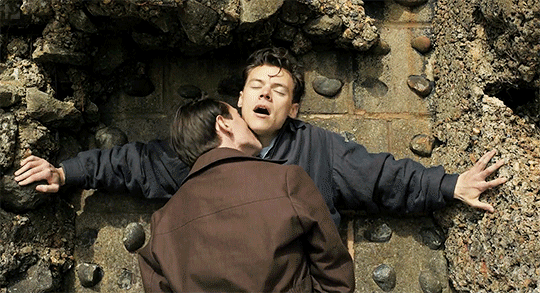
The Moon's association with fluidity, hidden depths, and possessing understanding of emotions and identity makes these actors particularly adept at portraying complex, non-traditional roles (they are great at portraying emotions at all levels of intensity in general, with a prime example being Leonardo DiCaprio [Hasta moon and Asc. moon in 1st house]), who is known to be a phenomenal actor, almost shapeshifting into whatever a movie expects of him and displaying deep, powerful emotions). However, that being the case, Ketu and Rahu might still be more prominent when it comes to this trope of casting straight men to play gay roles, possibly due to homosexuality often being seen merely as the act of having sex with other men, rather than an intimately personal aspect of identity that has an impact on all areas of an individual’s life. This has the effect of reducing gay characters to straight men more willing to engage with ideas seen as non-conventional or morally perverse (more commonly associated with Rahu and Ketu), while still maintaining their straight charm that appeals to mainstream audiences. It is easier to depict gay men as "devouring" or Ketu-like, as seen in associations with Mula Nakshatra, which is related to the act of excretion from the anus, but this narrow depiction overlooks the complexity of sexual orientation, reducing it to pure physicality of external behavior. It fails to acknowledge that being gay encompasses a broad array of emotions, experiences, and identities far beyond superficial characteristics. Moon-dominant mens’ ability to resonate with and express a wide spectrum of human experiences, including those that challenge conventional norms, is enhanced by their lunar characteristics, but these themes might also be more prone to attracting false representation due to widespread misunderstandings. I’d also like to make it known that I am aware that there are many gay and bi Moon, Rahu, and Ketu-dominant men as well; they just aren’t nearly as common and hardly, if ever, get casted in the kind of deeper gay roles I'm referring to.
Continuing this exploration, it's evident that the very qualities that lend Moon-dominant men their depth, intrigue, and warmth can also lead to significant challenges. The Moon's inherent receptivity endows these individuals with a remarkable adaptability, which, while often a strength, can manifest in less positive avenues. Their exceptional ability to influence perceptions and beliefs, a direct result of their emotional responsiveness and innate understanding of the mind's energies, can become problematic. In certain circumstances, this lunar influence may veer into darker territories with one major potential downside in particular being emotional manipulation, where their intuitive grasp of human emotions can be misused for personal gain or to sway others unduly. Their innate power over emotion and human psychology can lead them to engage in behaviors such as lying, espionage, cheating/betrayal, infidelity, illegal clandestine activities, and exploitation. The Moon's association with hidden aspects and the subconscious mind makes its natives highly skilled at navigating these activities, sometimes even leading them into antisocial or unethical paths, which can be seen in many different media portrayals I’ll cover later on. But for now, I will point to the personal life example of Ryan Philippe (Shravana asc. & Hasta mercury), who is notorious for his multiple instances of cheating on his wife and other subsequent partners, in addition to a history of drug misuse and allegations of domestic violence. An important thing to note when I speak about these things, however, is that while they can be masters of manipulation, Moon-nakshatra men do not possess complete control over the mind to the point where they always get people to do anything they want. Similar to the Moon relying on the Sun's light, their "power" actually depends on people willing to project onto and exchange energy with them, which can make Moon-dominant men extremely vulnerable, even more so than Moon women (people will instinctually try to defend moon women because they perceive them as being pure and innocent, unable to protect themselves; the same sentiment is not afforded to Moon men, who people think should be able to defend themselves with their physical power). In fact, Moon-dominant men often struggle to set boundaries due to a fear of direct confrontation as well as a desire to be what other people want of them, often worshipping the people they are closest to (they really want respect and attention from others and will endure harsh treatment or act untoward if it means getting that from someone they respect themselves, sometimes to an unhealthy extreme). That brings me to my next point of abuse... Whether inflicted or incurred, abuse (especially relating to domesticity and women) is another shadowy aspect of the Moon's influence in Vedic astrology, aligning with many of the experiences of Moon-dominant men in media and in real life. The frequent association of moon-dominant men with themes of abuse in media – be it as perpetrators, victims, or both – intertwines notions of vulnerability and aggression, showing the darker side that emotions can take, and subsequently, the darker side humanity can take as well. Overall, it makes sense why people often connect Moon men to ideas of abuse in media and in real life, such as with Evan Peters (Hasta moon and Shravana mercury) in “American Horror Story—Coven” where he was sexually abused by his mother (among other things; that show put him through it...), Christian Bale (Shravana sun) in American Psycho being abusive towards women, Tom Hardy (Hasta moon and Rahu) in “Peaky Blinders” being extremely violent and hedonistic, etc.
(Add-on: This is a bit of sensitive topic related to sexualization, so discretion is advised. Just as women traditionally face sexual objectification, Moon-dominant men may also encounter similar treatment due to their inherent passivity and receptive nature, leading to sexualization and other forms of scrutiny that stem from societal tendencies to view individuals who are more passive and receptive as feminine as being more accessible to take advantage of. This sexualization, particularly prevalent in the portrayal of these men in scenes of nudity [I've yet to find a Moon-dominant male actor who has not done a nude scene, even though many speak about how they did not want to do it at the time and felt uncomfortable] or in the adult film industry (an industry known for its connections with abuse) where I've found Moon men to be most over-represented in terms of planetary dominance, showcases a societal inclination to exploit those exhibiting traits diverging from traditional assertiveness.)
(GIF contexts: The first GIF shows Evan Peters in American Horror Story Crying. The second GIF is of Tom Hardy in Peaky Blinders smoking.)
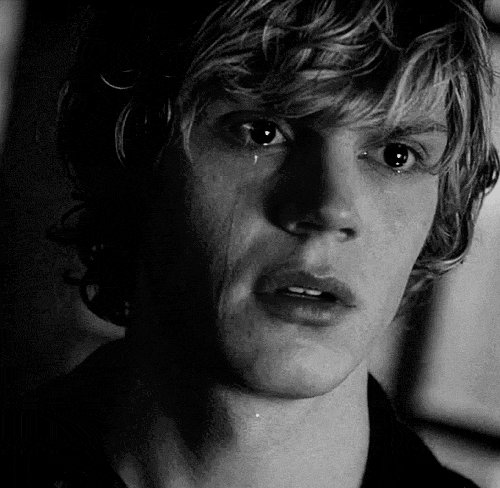

In the film industry, the energies of Moon-dominant men, characterized by their complex emotions, adaptability, and concealed depths, are astutely recognized by directors. This insight informs casting decisions, often placing Moon-dominant actors in roles that mirror the multifaceted nature inherent in them. Christian Bale's (Shravana sun) portrayal of Jim Luther in "Harsh Times" exemplifies this, exploring the darker recesses of the human psyche, a reflection of the Moon's association with concealed motives and intricate emotional situations. Similarly, Denzel Washington's (Shravana moon, Hasta asc.) performances in "American Gangster" and "Training Day" depict a tough exterior masking a softer core, Michele Morrone (Hasta sun & venus and Shravana rahu) in "365 Days" intertwines criminal elements with deep emotional entanglement, and Tom Hiddleston's (this one is super interesting because, while he doesn't have any primary moon placements, he does have Hasta jupiter & saturn— the moon nakshatra ruler and subruler of his chart plus Shravana Venus and ketu, so I consider him moon-dominant) Loki across Marvel films embodies cunning coupled with hidden vulnerability. Matt Daddario (see top of post) and Matt Bomer (Hasta moon, mercury, and rahu), in "Shadowhunters" and "White Collar" respectively, delve into the realms of a secret society of demon hunting & then crime/subterfuge with personal attachments to it, personifying the Moon's nature.
(GIF contexts: The first GIF shows Michele Morrone in 365 days shirtless and talking while looking down. The second GIF is taken from White Collar showing Matt Bomer talking frantically.)


Zachary Levi as Flynn Ryder personifies this duality - mischievous yet sensitive, conniving yet protective, masculine yet feminine, seeking introspective depth yet maintaining material asperations, and so on. Followed by Henry Cavill's roles, particularly Superman and Geralt, further illustrate this theme of his invincible, hyper-masculine superhero persona of Superman veiling the sensitive, complex nature of Clark Kent that he must keep hidden through great discipline (The original actor for Superman Kirk Alyn was also moon dominant (Hasta sun and mars with a lot of his chart's energy tracing back to sun). One the other hand, Christoper Reeve– arguably one of the most popular actors to play Superman– has his Sun and Mercury less than one degree away from being in Hasta, but overall, his chart is still Sun-dominated with a lot of Uttara Phalguni and Krikita, which makes sense because one: it was old hollywood, and two: the reason people love him is for his portrayal as the hyper-masculine persona of Superman, which would have been closer to Reeve's true nature anyway. In my opinion, his portrayal as Clark Kent is kind of bad because he treats that like it is supposed to be his geeky alter-ego rather than the fact that he would have been raised as Clark Kent– the humble farm boy from Kansas, not as Superman. Anyway, rant over). And Geralt, who presents a facade of absolute masculine strength defeating monsters for a living and projecting a sense of detachment from others, all while concealing a deeper, more nurturing and intimate side of himself. These portrayals, necessitating depth and often grappling with themes of manipulation and other complex moral dynamics, go hand-in-hand with the Moon's influence on hidden emotional strata and ethical complexities. The performances of these actors align with the experiences of many Moon-dominant men, reflecting the nature of their personalities. (Thank you so much to anyone who read this entire thing! 🙂 I know it’s a ton of information to get through, so I do really appreciate any time and effort people put into reading this!)
#vedic astrology#astrology#astrology observations#nakshatras#zodiac#astro community#astro notes#astro observations#zodiac signs#astrology notes#vedic chart#vedic astro observations#vedic astro notes#vedic texts#vedic mythology#lagna#astro placements#astroblr#sidereal astrology#capricorn#virgo#taurus#moon men#moon-dominant men
136 notes
·
View notes
Photo

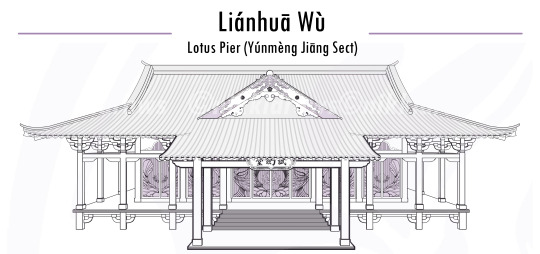
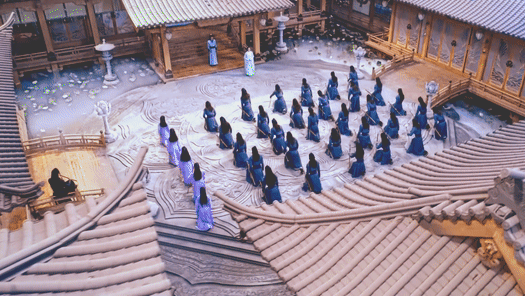



我做梦都想回去...
Even in my dreams, I want to go back…
The Untamed locations: Lotus Pier 莲花坞/Liánhuā Wù
It’s finally here! The third installment in my ongoing Chén Qíng Lìng drafting saga, Lotus Pier! As the residence of the Yúnmèng Jiāng Sect, Lotus Pier (莲花坞/Liánhuā Wù) is arguably one of the most important locations in the narrative of Mó Dào Zǔ Shī. Built among sprawling lotus ponds in the lazy shallows of a vast, meandering river, Lotus Pier shapes the halcyon days of the Jiāng siblings’ youth. It is a warm and lively place, its people welcoming and carefree.
The complete diagram:

(Full set details/meta below.)
Part 1: The Jingshi
Part 2: The Hanshi
Prints now available at ✨ INPRNT! ✨
You can also support me on Ko-fi ☕
Honestly, the few gifs I have used do not come close to showing you the huge scale, or the level of detail and care that has evidently been put into this set by the CQL production team.
Before I attempt to describe the place that shaped much of our main characters’ lives, let me first share with you the set layout with reference to some aspects of traditional Chinese architecture (and please bear in mind, I’m not an authority on the subject. Links to sources/appropriate references are provided).
Understanding the set layout:
The main compound of Lotus Pier is set out loosely following the typical, traditional layout for residences containing a courtyard.* Rooms are placed at the four cardinal points, creating a central axis and a secondary horizontal axis. With the courtyard facing south, the most important buildings are placed to the rear (north), such as the parents and grandparents’ bedrooms and the ancestral hall, while the siderooms (typically for the sons’ families) are placed to the east and west according to auspicious philosophies (like fēng shuǐ) and social hierarchy:

* At least, in the northern regions of China. Although Héngdiàn World Studios, where most historical and xiānxiá dramas are filmed, is located in Zhèjiāng, it seems a lot of the sets at Hengdian are based on northern designs.
In true “courtyard houses” (sìhéyuàn or sānhéyuàn, depending on whether the courtyard is fully enclosed), this quadrangle layout would then repeat along the central (N-S) axis if the residence contains one or more ‘inner courtyards’ (Fig.3 below):

However, I would not call Lotus Pier a true “courtyard house” as it is freer and more spacious in form than, say, the Hanshi’s courtyard design** and both sets are part of a larger compound anyway, rather than a standalone residence for a single family - so the comparison may be redundant. For instance, Lotus Pier’s stilt foundation and large, sloping roofs also bear an interesting resemblence to the wooden storied houses of Yúnnán, which is a completely different type of vernacular architecture.
** That being said, there is a wealth of research on the different variations in this type of vernacular architecture [x] [x], which does include differences in siheyuan design based on climate (wherein the buildings are quite generously spaced apart, and the courtyard much larger, to deal with the warmer climate in southern regions of China).
Nevertheless, we can see the cultural and cosmic philosophies which influence these courtyard homes used at times in the design of Lotus Pier.
For instance, we see in episodes 14 and 18 that first Jiāng Chéng, and then Wèi Wúxiàn lived in the eastern room - both seperately and together - in their childhoods. (We can assume that Yànlí would have lived in a room nearer her parents, located in the back of the residence so as to lessen her appearance in public as an unwed daughter.)



(Although the two rooms have been dressed differently, the raised platform, reused props, and WWX’s running shot from the inside to the outside in episode 14 show that it is the same building. Additionally, you can head here for some ramblings on the interior of WWX’s room and some analysis on camera angles.)
You may also be able to see from these gifs that these siderooms are divided into three sections, which relates to the construction of traditional buildings in three or five ‘bay’ structures:
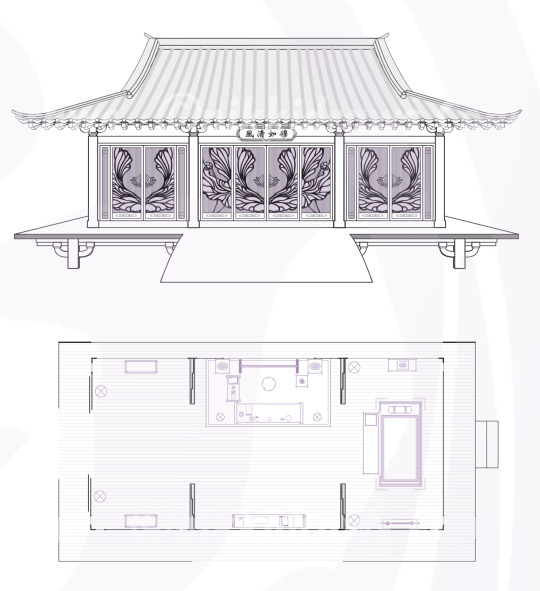
A ‘bay’ is the space between columns of a building. An even number of bays, or jiān/間, was thought to be unlucky, therefore the three bay structure was the basic layout of a commoner’s home, with additional bays added based on the need for space or the wealth of a family.
Interestingly, the room on the west side of the courtyard is shown to be Jiāng Fēngmián’s study, rather than another bedroom as I originally assumed - one that may have been for an older Jiang Cheng, although as the son and heir of the Jiang famly, his room would traditionally remain on the eastern side of the house (where WWX’s is). Then again, the main courtyard is an odd place for a bedroom in the first place, so perhaps we might be looking at a conflation of public and private spaces due to constraints on the set designers.
As a sidenote, JFM’s study appears to back onto a private lake, seen through the rear viewing window. I think this must be CGI, however, as I can find no angle of the set that shows this exists as part of the structure.

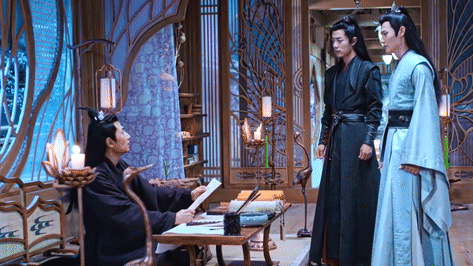
With all this said, let’s not forget that this is a xiānxiá drama: historical accuracy is not the goal. Instead, the producers took their time finding a ‘cultural location’ for each Sect, through which they could develop a more artistic aesthetic by drawing on the atmosphere and charm of their desired location. This brings us to the set’s design, and what it may represent about the people of MDZS’s Yunmeng.
The set’s design:
For the Yunmeng Jiang, producer Yáng Xià states in the link above that the showrunners drew inspiration from Húběi province, particularly the Jiānghàn plain that now lies in the heart of Wǔhàn. It is here the Hàn river joins the vast flow of the Yangtze as it meanders its way through the eastern provinces of Central China.
Just as Wuhan has been a major port city since the earliest dynasties of Imperial China, it’s fair to assume that the river that flows through MDZS’s Yunmeng has likewise influenced those living on its banks:

One of our first, and repeated, impressions of Lotus Pier and Yunmeng is how lively and welcoming this busy harbor and its people are. A major transport hub in its own right, with links to Lánlíng, Yumeng people are at home on the water.

The Jiang are unrestrained and easy-going, open-minded and generous. To reflect this, Lotus Pier was likewise built to be “broad and open”, the easy curves of the roofs and the wide, open walkways creating a sense of transparency and openness; the fluttering gauze curtains soften and compliment what otherwise might be an imposingly broad structure of warm-coloured wood:

The marketplace that sprawls from the main landing likewise tells us that Lotus Pier and the wider Yunmeng area is a place of trade and craftsmanship.
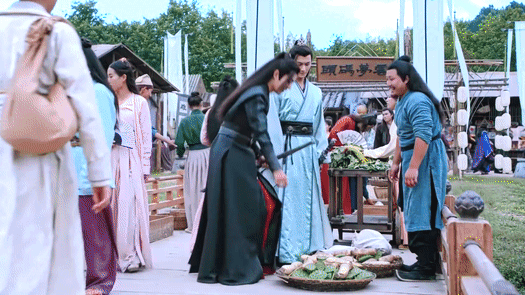
We see lotus seeds and pods harvested frequently, and as strong swimmers and talented fishermen, we might assume that the Yunmeng people are also skilled at weaving fishing nets and other such tools from the abundance of natural materials the fertile floodplains afford them.
As an aside, I do wonder why JFM decided to decorate his seat of power with rolls of reed matting/blinds.

I like to think they’re wares from the market, to display his peoples’ craftsmanship. You have to admit, the effect is impressive, immitating an unfurling lotus:
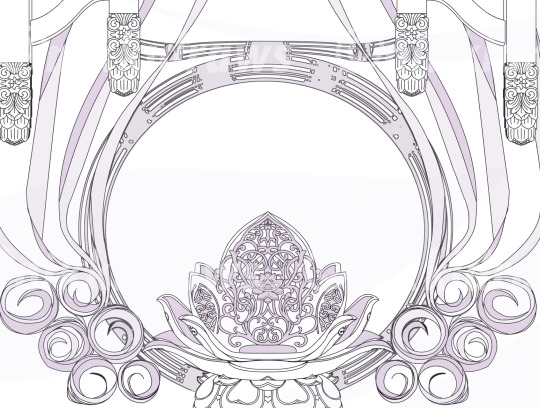
The one area that intrigues me the most in this main courtyard, however, is the kitchen. The private dock in the kitchen really exemplifies how the river has had such a huge influence on the design of Lotus Pier, by virtue of the waterborne livelihood it has curated among the Yunmeng people:
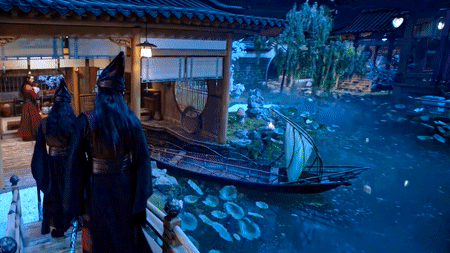


I like to imagine that fresh produce from the market would arrive by boat early in the morning, and Yanli would be there to help unload the goods while she prepares breakfast for her family...
What struck me most, though, during the course of this whole study was the dreamy, almost fantastical quality to the set. As I said above, the xianxia genre allows much more creative license with the aesthetic of the Sects and their domains, as the genre does not need to replicate a time or place with rigid historical accuracy. As such, much care and ingenuinty has been taken by the show’s designers to merge the Pier with the river, giving the impression that, like the lotus flowers that give it its name, the Pier also floats on the water itself.

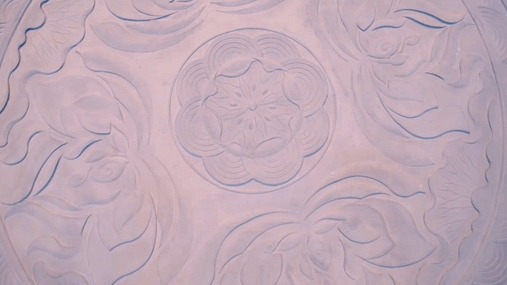
To that end, let’s lastly think about the lotus imagery we see around the set, and how it applies to the role of Lotus Pier as a place in the narrative.
The symbolism of the lotus
Revered for its beauty and much loved for its versitility in Asian cuisine and traditional Chinese medicine, the lotus holds significance in Chinese culture for many reasons. As one of the 'Flowers of the Four Seaons' (四季名花, Sìjì Mínghuā), the lotus flower represents summer, blooming through the season in the shallows of slow-moving rivers and river deltas.

「出淤泥而不染 / chū yūní ér bù rǎn」, an idiom meaning “growing out of mud, but remaining untainted”, is often attributed to a poem by controversial Confucian and Neo-Confucian scholar Zhōu Dūnyí called 'On the Love of the Lotus' ( 爱莲说, Ài Lián Shuō). Zhou calls the lotus flower a "gentleman among flowers" (not to be confused with the Four Gentlemen) as, rising dignified from the mud, it exemplifies the cosmic and spiritual harmony all humans should aspire to achieve. As such, it represents a moral ideal of dignity and integrity for a Confucian gentleman. As Zhou writes, “I love only the lotus, for rising from the mud yet remaining unstained; bathed by pure currents and yet not seductive.”
We cannot wholly attribute this idiom to Zhou, however, as this metaphor of the lotus flower, symbollic of purity of mind and body as it rises out of the muddy waters of worldly affairs, actually has its roots in the religious teachings of Buddhism and the Lotus Sutra. In it, the sacred lotus symbolises spiritual enlightenment and self-actualisation, where one is able to detach themselves from worldly affairs and overcome personal sufferings.
N.B. 18/04/2023 Edits have been made to reflect more accurate context regarding the prevailance of Buddhist thought in China since its introduction in the Han dynasty, and how Zhou’s ‘On the Love of the Lotus’ drew upon its teachings. See here for the original text and a review of its inaccuracies, as well as further resources.
How can we relate this back to the setting, Lotus Pier, and the Yunmeng Jiang? I think the most obvious parallel has to be the burning of Lotus Pier.
The event is the catalyst for a number of tragedies that occur throughout the narrative, and the Jiang siblings' attempts to reconcile the many layers of guilt, blame and grief they each feel with the enormity of losing their entire Sect, their home, their bonds with each other - the lotus emblem of their Sect is perhaps a reminder that there is no happiness without hardship.
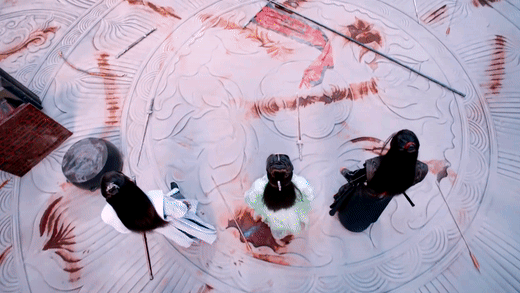
Of course, more important than its cosmic symbolism, for these siblings lotus ponds represent home, and are a way the three siblings can remain connected as they travel seperate paths in life, forming new families after the tragedy of their own:

In the scene pictured above - where WWX, after many months in self-imposed exile, succeeds in cultivating his lotus pond in the Burial Mounds - the pond represents his longing for Lotus Pier while also bringing him some comfort and connection to what he has lost. Just as Jīn Zixuān seeks to bring comfort to Yanli by planting a lotus pond for her, too:


(Bonus gif of a different type of "gentlemen rising from the mud”):

But as an aside, it's also interesting to note that WWX tells A-Yuan in that above scene, that the lotus seeds are not to be eaten because they are grown in the soil of the Burial Mounds. Instead, they are 'the perfect thing to protect from evil spirits'. This may be a simple child’s tale for WWX to discourage A-Yuan from eating the tainted seeds, or it may refer to the spiritual purity the lotus symbolises. But as an interesting coincidence, lotus plants actually have the potential to filter nitrogen, phosphorous, and heavy metals from watersources, so it’s possible they taste bad because they are literally cleansing the soil of the Burial Mounds.
It seems appropriate, then, that WWX is tied closely to this lotus motif, perhaps even moreso than Jiang Yanli and Jiang Cheng. This is especially poignant when we consider that the lotus is also symbollic of resurrection and rebirth: the blooms, closing and opening with the sun in a daily cycle, can be compared to the cycle of reincarnation.
A great deal of the narrative focuses upon WWX’s decision to forge his own path through life, a ‘single-log bridge’ that sweeps him away from convention and propriety that governs the rest of the cultivation world as he struggles to maintain his own integrity and compassion. He suffers for this choice, especially once he gives up his golden core and is thought to be actively choosing an ‘evil’ path. Yanli even dreams of him floating away from Lotus Pier, carried on the rapid current of the river:
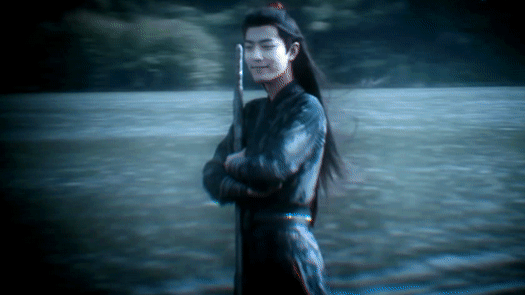
After his resurrection, however, it seems WWX has been able to finally rise above the Sects’ biases and political machinations. Once the Yin Iron has finally been sealed away, and the mystery of the Fierce Corpse solved, he no longer has any obligation to stay in those muddy waters of the cultivation world. He is free to wander, as his parents did - the single log bride widening to encompass the whole world.

Although still tied to the world by his love for his family and friends, we could say that WWX is close to that enlightenment the lotus represents. He has risen from the mud and, despite all his suffering, has remained untainted.
Bonus details!
If you’ve made it this far, congratulations! This got... so long... But of course, I had to do Lotus Pier justice as such a beautiful and thematic set. As a final point, here are some small details you may have missed or that I couldn’t fit in the main analysis!
Here is a cute interior shot of WWX’s room, and a view of the rear courtyard that shows the moon gate entrance, which presumably provides access for boats to dock in the kitchen:

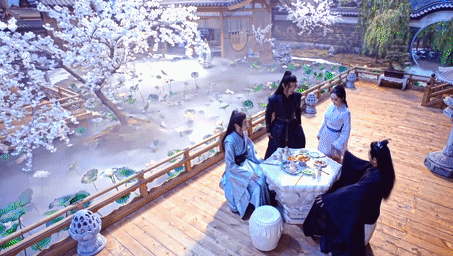
Also join me in appreciating how detailed the design on the door panels is! So much so that I couldn’t do the finer details justice in my sketch:
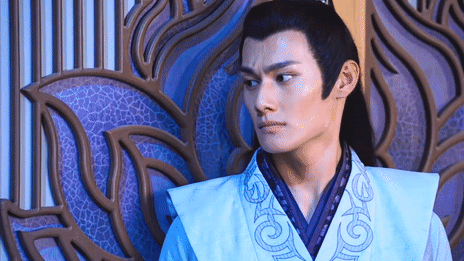
Special mention to the fish doorhandles on the main hall, as well. As a Pisces, this brings me joy.

And finally, some reference shots for the gate:


As always, thank you everyone for your continued support and encouragement - and your patience! Lotus Pier was a massive project, that has taken me over a year to complete. I am so proud to finally present it to you, and bring you the news that I have finally opened a print shop! As always, you can also buy me a coffee on kofi to show you support.
#nikkidraws#lotus pier#set design saga#cql set design#the untamed set design#lianhua wu#yunmeng jiang sect#yunmeng jiang#jiang cheng#jiang yanli#wei wuxian#yunmeng siblings#yunmeng brothers#twin prides#twin prides of yunmeng#set design#cql fanart#cql fan art#the untamed fanart#the untamed fan art#cql meta#the untamed meta#set analysis#character analysis#wwx analysis#cql wwx#chinese architecture#fantasy architecture#fantasy map#fantasy set design
1K notes
·
View notes
Text
Apropos of recent discussion around whether or not the Medicine Seller fucks, I do see him as very much a sexual being, and I think that part of his nature is significant. I think he embodies sexuality as a primal, generative unity of masculine and feminine, in keeping with the philosophy of yin and yang. He represents sexuality as something sacred - hence maybe the paradoxical impression that he's both highly sexual and also untouchable.
I also think his sexuality relates to the mind-body connection, which is important in Eastern medicine: the idea that the relationship with the body is connected to the relationship with the mind. (This relationship is why physical grounding, usually through focus on the breath, is important in meditation practice: it's as much about reconnecting with the body as it is about reconnecting with the mind.)
The Medicine Seller's work is with the mind, but in Mononoke the body is also a central theme. Especially important in every arc is the way women's bodies are treated. Mononoke explores a world where women's bodies are abused and exploited and their wishes and desires are denied. Their negative experiences of sexuality and with their own bodies are what create all of the mononoke - manifestations of their mental and emotional pain. The zashiki warashi are created by their mothers' pain; the umi bozu is created by Genkei's denial of Oyo; the nopperabou is created by the repression of Ochou's desires; the nue is created from the body of a woman men treated as an object; and both bakeneko arise from extreme violence done to Tamaki and to Setsuko.
Especially for women, I think the Medicine Seller's influence facilitates a healing of their connection to the body and to sexuality. He presents a concept of sexuality that women can experience as positive and that's as much about their desires as it is about men's, and he also presents an image of the feminine as something beautiful and deserving of respect. His presence becomes a grounding force that draws injured women back into contact with their physical experiences along with their mental ones - allowing them to heal their relationships with their bodies by confronting their physical trauma at the same time as it allows them to heal their relationships with their minds by confronting their mental trauma. Both are needed for complete healing, or for exorcism of the mononoke, since they're equally significant aspects of the Form, Truth, and Regret.
#mononoke theory#kusuriuri#mononoke 2007#ayakashi bakeneko#I realize this does little to settle the question of whether or not the medicine seller fucks#but does he *need* to?
82 notes
·
View notes
Text

Happy birthday, Steve Biko! (December 18, 1946)
An anti-apartheid activist and theorist, Steve Biko grew up in the Eastern Cape province of South Africa and studied medicine at the University of Natal, where he became involved in the student movement against the white supremacist social system of the country, helping to found the South African Students' Organisation. Influenced by Frantz Fanon and the Black Power movement, Biko articulated a philosophy he called Black Consciousness, which incorporated African nationalist and African socialist ideas; Biko coined the phrase "Black is beautiful." Although the apartheid government initially supported Black Consciousness as they believed it ultimately comported with the segregationist ideals of the apartheid system, they came to view him as a threat and employed the legal, legislative, and law enforcement systems to curtail his activities. After an arrest in 1977, Biko was beaten to death by South African police.
"The most potent weapon in the hands of the oppressor is the mind of the oppressed."
388 notes
·
View notes
Text
I think calling Byleth's personal class “the Enlightened One” was a mistake. Being “enlightened” means that Byleth's outlook is rational, modern and well-informed regardless of which route Byleth picks. In a way, it makes every route sound more equal. And if we think about this from the Western perspective of the Enlightenment era, it would carry implications of being more individualistic, reasonable, and breaking away from tradition which would lean more into supporting Flower. The spiritual awakening aspect is a lot further from people's minds.
Byleth can side with Edelgard, which results in them no longer being enlightened at the end of the route, but the path there still would come across as Byleth having chosen that because of the aforementioned outlook.
Nirvana, on the other hand, reflects Byleth's spiritual state, and the overall messages of the game. It means overcoming attachment, not letting your positive feelings toward something or someone prevent you from doing the right thing. The opposite is true as well, you don't let your own personal aversions or hatreds get in your way as well. It means that when you're presented with information that contradicts your beliefs or even disproves them, you adapt your way of looking at the world in response. Focusing on the self, the more individualistic outlook, can trap people in a cycle of suffering for these reasons. Eastern philosophy focuses more on the good of the group rather than the individual as a result, in addition to knowing your place within society. You are expected to be benevolent to those who you hold power, influence or authority over, while also being dutiful to those above you.
Honestly, how Rhea and Edelgard are presented makes sense on a thematic level. The game tries to make the player adverse to Rhea early on, but she ends up being revealed the good guy with legit reasons for doing what she does. We are supposed to let go of our earlier perception of her as we learn more about the world, and the game puts that at the feet of the player to do so. Edelgard is the opposite, the game tries to make us like her, become attached to her, only to drop info that contradicts her claims in addition to her being the bad guy. And if we let our attachment to her get in the way of making the right choice, we prove that we are unworthy of bearing the title of Nirvana.
But divorcing the game from those themes, like the Western translation does, ultimately screws up the message.
And, you know, I read the translation notes for The Three Body Program, where Ken Liu talks about how translators need to get the point across regardless of cultural barriers. That it's not just about translating the story, but also the mindset of the creators. That the best translation don't make the work sound like it was originally written in English, but rather allow the reader access to the thinking patterns of it's native culture. By trying to make Houses more Western in it's messages, the translators failed their duties.
38 notes
·
View notes
Text



cao'an (thatched hermitage) and its manichaean remnants in jinjiang, fujian, china. though cao'an is on its surface not too different from other buddist temples, it was also manichaean, and may still be manichaean in secret. it's also one of the last standing historical manichaean places of worship in the world. this place has quite the history, so i placed it under a read more:
manichaeism is a former world religion of babylonian origin, reaching as far west as the roman empire and as far east as han china at its greatest extent. it combines elements of several other prominent religions and philosophies - the most notable factor of this is that it reveres founder mani as the final prophet in a line consisting of zoroaster, the gautama buddha, and jesus christ. it went mostly extinct due to persecution of followers throughout its multi-continent laity. manichaean places of worship were either entirely destroyed or appropriated in other parts of the world. it lasted much longer in china (until ming dynasty times) and still exists in some parts of fujian and zhejiang. these believers prefer to remain private about their current practice. what outsiders know about the religion is solely through historical records; because of its comparative longevity in china, many of those records come from there.
manichaeans tended to draw more from the religious/philosophical influences on manichaeism that were most familiar to them. (for example, while manichaeism in jerusalem may have looked more abrahamic, manichaeism in istakhr may have looked more zoroastrian.) in china, manichaeism assimilated to both buddhism and taoism; in the former case, much of it was adapted to be stylistically buddhist, and mani received the title of "buddha of light" and a life story resembling the gautama buddha's.
cao'an was constructed during the song dynasty era (specifically in the 960s), when persecution against manichaeans had been ongoing from emperor wuzong of tang's suppression of all foreign religions. (the same policies had affected zoroastrians, eastern syriac christians, and buddhists, but continued for manichaeans after.) at this time, many manichaean temples had buddhist or taoist affiliations, or disguised themselves as buddhist or taoist only. it became officially buddhist after manichaeism was banned in 1368. since abandoned, it was revived for explicit buddhist usage for a short period in the early 20th century. it's preserved as a cultural monument today.
cao'an has managed to preserve remnants of its manichaean affiliations. one is that, instead of a nianfo phrase usually seen in chinese buddhist temples, an inscription on a nearby stone dating to the 15th century reminded worshippers of "purity, light, power, and wisdom". this mantra is an adaption of manichaean cosmology in chinese manichaeism. the original stone was destroyed during the cultural revolution but the phrase was re-inscribed on another after. another is a statue that seems to portray the buddha, but is thought to actually portray mani. unlike other portrayals of the buddha, this one has long, straight hair which is worn down, different facial features and hand/head postures, and, at one point, facial hair. (this was filed off in the early 20th century by a buddhist monk to make him look more like the buddha.) it's also consistent with other portrayals of mani in chinese manichaean art.
#china#architecture#details#worship#manichaean#buddhist#shared space#my posts#'Are Manichaeans Ahl al-Kitāb' - the greatest thread in the history of Abbasid forums locked by Harun al-Rashid after 12239 pages of heate
26 notes
·
View notes
Text


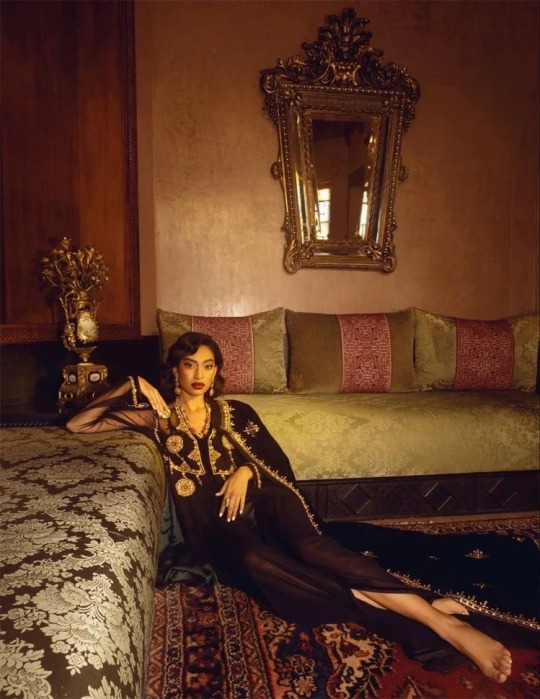

On the Role of Cultural Education in Self Identity and Hypergamy
I’ve been thinking a lot about education lately. Why is it that I’ve spent a decade and half in the traditional education system and still not felt like a “human”? Why is it that when I finally began getting “real world knowledge” it all felt new and that school hasn’t prepared me for any of that? Why did I still feel unrefined as a human being?
I remember being at an HNI event years ago and being absolutely blank faced about what was going on. I didn’t know any of the topics they were talking about. That’s when it first hit me - my education system had failed me in some way. I felt stupid, like a little goldfish in the ocean.
There’s more to life than what we’re taught inside the four walls of a classroom. This year I’m going to heavily focus on my “cultural education.”
For context because I don’t want to mislead anyone: I’m Asian, my parents are HNIs (which explains specific knowledge and accessibility to certain things), I do have privilege which I accept and try to make good out of (such as volunteer work, working on impact-driven businesses).
Cultural knowledge expansion is important because it shapes you as a person. You realise that life is not black and white - there’s so much more to it. You think more about things that truly matter and you focus less on superficial things. You realise that there’s always some historical knowledge you can apply to current times.
Best of all - you’re on track to being smarter, wiser, confident and sociable. Even if you may not know all the answers, at least you know what to question!
I’m at an age where I’ve had families asking my family about my marriage prospects (arranged marriages are common in my culture, I would 90% opt for one at a later age, arranged marriages are NOT forced marriages) and I want to be able to be “too good” for anyone and everyone. In my culture, we don’t marry individuals; we marry families. The family that I would ideally want to get married into should be up to my standard as well. I want a man to earn the right to be my partner, not the other way round, no matter how much money or influence he has. This is something that my father has drilled in my head from day 1 - never settle for just anyone.
However - how can I ask for things if I don’t bring them to the table myself? How can I ask for someone cultured, highly educated, intellectual - if I am not trying to be those things?
Things To Culturally Expand On (and this is exactly what I would teach my future children)
You don’t have to be an expert of any of these. But even knowing the ABCs can take you a long way. I do feel that exploring these would help me connect to my feminine energy further as well. Only classroom knowledge will not build you as a person.
1. Watching indie movies / niche movies on MUBI.com
2. Learning the basics of crafts (embroidery, cooking, etc)
3. Exploring literature (at the moment, eastern literature)
4. Herbal medicines (this does not replace allopathy, but I do think that herbal remedies can be useful for minor things)
5. Poetry
6. Appreciating classical music (I’ve always appreciated western classical music because my mum insisted on my sibling and I learning the violin/piano (my sibling is really gifted)) especially eastern classical
7. Philosophy, eastern and western
8. Understanding and appreciating traditional dances
9. Working more on my native language
10. Being refined in my culture’s history and geography
#c suite#powerful woman#ceo aesthetic#personal growth#that girl#productivity#strong women#getting your life together#feminine energy#balance#history#culture#cultural#ethnic#education#future self#self growth#independence#finding myself#marriage#hypergamy#female education#learning#cultural appreciation#diversity#traditional#values#ambition#high value#high value woman
202 notes
·
View notes
Text
Similarities in Symbolism

The unicursal hexagram of Thelema and the Eastern Yin Yang symbol offer insightful philosophical parallels with the intriguing principles of quantum physics, particularly resonating with Niels Bohr’s concept of complementarity. This union gives birth to technoshamanism.
The Yin Yang and Quantum Theory:
In the Yin Yang’s flowing, interconnected nature, we see a reflection of the unicursal hexagram’s depiction of inseparable, opposing forces. This symbolic resonance is mirrored in the realm of quantum theory, where subatomic particles exist in a probabilistic haze, oscillating between contradictory states such as wave and particle, influenced by observation. This phenomenon of quantum indeterminacy collapsing upon measurement parallels the Yin Yang, which beautifully illustrates the interdependence and mutual definition of seemingly opposite forces.
The Unicursal Hexagram and Connection of Opposites
The unicursal hexagram, representing the unity of opposites, resonates deeply with the principles of technoshamanism. This symbol’s depiction of interconnected forces is reflective of how technoshamanism aims to merge the mystical with the technological, suggesting that the ancient wisdom embodied in such symbols can inform and enrich our understanding of modern scientific concepts.
Heisenberg’s Uncertainty and Symbolic Parallels:
Moreover, Heisenberg’s uncertainty principle, a cornerstone of quantum mechanics, states that precision in measuring one quantum property inherently limits knowledge of its complement. This concept finds a symbolic parallel in the Yin Yang, where each aspect contains and engenders the other in a perpetual, interwoven dance.
Transcending Dualism:
Additionally, both the unicursal hexagram and the Yin Yang transcend traditional dualistic perspectives. They reflect the counterintuitive nature of the quantum world, where particles don’t possess a singular, defined state but exist across a spectrum of probable characteristics. This aligns with a holistic view, moving beyond binary divisions to embrace a complex interplay of complementary forces. These symbols and quantum principles collectively challenge the classical, deterministic understanding of the universe, advocating for a more probabilistic and paradoxical interpretation. The unicursal hexagram and Yin Yang symbolize that apparent contradictions in existence are not at odds but rather form an interconnected, nuanced whole. They exemplify how opposites are generative, not negating, weaving together the complex tapestry of existence. Embracing these relationships, as illustrated by both symbols, aligns us with the harmonious nature of the universe, echoing the counterintuitive insights of the uncertainty principle.
Thelema’s Principle of 0=2:
The Thelemic principle of 0=2, deeply rooted in Aleister Crowley’s mystical system, provides a unique philosophical underpinning that complements the themes discussed in this article. At its core, this principle embodies the concept of unity emerging from duality, a fundamental tenet in Thelemic philosophy. The equation 0=2, in Thelemic thought, symbolizes the idea that the apparent duality of existence (represented by 2) ultimately originates from and returns to a state of non-duality or nothingness (represented by 0). This aligns closely with the concepts in quantum physics, where the seemingly dual nature of particles, as both waves and particles, emerges from a singular, undifferentiated quantum field. Just as the unicursal hexagram and Yin Yang depict the inseparable interplay of opposites, the principle of 0=2 in Thelema suggests that all dualities — light and dark, creation and destruction, positive and negative — are intrinsically connected, emanating from a singular source.
0=2 and Wave-Particle:
In the context of quantum mechanics, one can draw parallels between the Thelemic principle of 0=2 and the wave-particle duality. Just as the 0 represents the undifferentiated, unified field, the number 2 reflects the dual nature of quantum entities. This duality is not a permanent state but rather a manifestation of the underlying unity. It reflects the much like the quantum state of a particle, not fixed until it is observed. This aligns with the Thelemic view that apparent dualities are merely different expressions of a single, underlying reality. Moreover, the principle of 0=2 resonates with the idea of quantum superposition, where particles exist in multiple states simultaneously until measured. In Thelemic philosophy, this can be seen as the myriad manifestations of the universe (the number 2) emerging from the void or the absence of existence (0). It suggests that the universe’s complexities, including its paradoxes and contradictions, are integral aspects of a unified whole, challenging our conventional understanding of separation and distinction.
Technoshamanism: Quantum Physics and Philosophical Symbolism:
This philosophical exploration leads us to consider the significant role of metrics in confirming the existence of phenomena, a concept deeply rooted in both quantum mechanics and the interpretation of symbols. In quantum physics, the very act of measuring a particle’s properties – position, momentum, or spin – solidifies its existence in a specific state, transitioning it from a probability to a reality. This principle aligns with the symbolism of the unicursal hexagram and Yin Yang, where the definition of one aspect inherently confirms the existence of its counterpart. Just as the measurement of a quantum particle’s position simultaneously acknowledges the existence of its momentum, the presence of Yin intrinsically confirms the existence of Yang. This interplay of measurement and existence underpins both the mystic symbolism of these ancient icons and the empirical foundations of quantum mechanics, illustrating a profound unity between philosophical concepts and scientific principles. The existence of a metric, be it in physical measurements or symbolic interpretations, serves as a bridge between potentiality and reality, reinforcing the notion that our understanding and observation are integral to the manifestation of existence itself.
Quantum Physics: A Magical Rulebook
Quantum physics, often perceived as a mystical domain due to its counterintuitive principles, aligns well with the technoshamanic perspective. This field’s exploration of particles existing in multiple states aligns with the technoshamanic belief in the coexistence of spiritual and physical realms. It posits that technology, when applied with an understanding of shamanic wisdom, can unlock new dimensions of understanding, similar to how the Yin Yang symbol encapsulates the duality yet unity of existence.
Technoshamanism: Merging Ancient Mysticism with Modern Technology
Technoshamanism is a contemporary concept that fuses the ancient practices of shamanism with the advancements of modern technology and science. It embodies the idea that the spiritual insights and rituals of shamans, when integrated with the empirical approach of technology and quantum physics, can lead to a deeper, more holistic understanding of reality. Technoshamans utilize both the symbolic wisdom of traditions, like the unicursal hexagram and the Yin Yang, and the empirical data of quantum mechanics, proposing that this synthesis can offer a more nuanced and interconnected view of the universe. This approach suggests a harmonious blend of spiritual intuition and scientific inquiry, bridging the gap between metaphysical beliefs and technological advancements.
Conclusion:
In conclusion, the integration of the unicursal hexagram, Yin Yang, and quantum principles presents a compelling view of reality. These concepts advocate for a universe understood not in terms of isolated absolutes but as a network of relational dynamics and potentials. They encourage transcending perceived divisions, viewing existence as a unified, complementary dance. This convergence of ancient symbolism and modern physics suggests a profound truth: existence is fundamentally an interplay of harmonious opposites, a concept now increasingly validated by the advances in quantum mechanics.
youtube
15 notes
·
View notes
Text
SAS tracking the tulpa
So here’s some interesting things I just learned.
This is a very basic overview, no, it’s not going to cover all the nuance, it’s just something interesting that puts a twist on the whole tulpa thing. Please see my statement at the end.
The work of Helena Blavatsky (HB), a Russian mystic, influenced the work of Alexandra David-Néel (ADN), the person who basically brought tulpamancy to the public eye in a real way
HB claimed to have travelled to Tibet, which was closed to foreigners, and the movement of women was restricted during this period (ie. she probably didn’t actually go and her books are fiction-- OH, and she wanted to lead an expedition into Peru to find the tunnels to hollow earth). As well, ADN is actually credited as being the first woman to visit Tibet, not HB before her. [x]
BUT, here’s a fun twist.
It’s possible that ADN never went to Tibet, either (that’s a link, click it)
So what does that mean for this “cultural exchange” if it was never actually exchanged?
But let’s assume she did go, and she did sneak into Tibet posing as a beggar, and continue on with the 💲 💲 💲 money 💲 💲 💲
The work of HB first brought mysticism and eastern religions to the West, and had already resulted in a financial boom around the topic of eastern religion and mysticism. Thus, when ADN started publishing her (largely fictionalized and dramatized) books around the same time, she basically made all of the money. That link is actually an extremely interesting read. Especially the part where she’s quoted as saying:
Anticlericalism is out of fashion: it is one result of the war. When men are scared they turn to the gods, to the supernatural, like children that hang to their mother’s skirts. A breeze of spirituality blows over the world alongside with the blast of the cannonballs that rip through the air. Vulgar religiosity will turn into longing for philosophy in the larger-scale minds. I have some idea that my books on Vedanta and Tibetan mysticism are likely to meet the needs of many readers after the storm.
So what does it mean for the “cultural exchange” if most of her work is largely considered fiction, rather than travel or auto-biographical?
Let’s talk about tulpas, though.
Anyone who has read “Tracking the Tulpa” will recognize some of the following names, but there was one point in that article that caught me off guard. The statement that ADN was the first to use tulpa.

ADN probably actually pulled inspiration from the Tibetan Book of the Dead (called tulpai-ku within, she wrote it more as she would have pronounced it) mostly translated by Dawa Samdup (DS) in 1927, who had worked with and been very close with ADN. Her use of tulpa was in 1929. [x] (I died reading that paper)
DS died in 1922, though, and Walter Evan-Wents, who had a terrible grasp on the language, finished off the book with his own interpretations and translations.
Point is, she had likely been aware of the concept prior to her book and the supposed events contained within it.
Which brings us back to her fiction writing and making those big dollars to entertain those damn, post war, depressed white people.
Again, this is by no means meant to be a history lesson, you all can go and do your own research. I am largely unfamiliar with Buddhism and Tibet, but I was reading about HB and came across her connection to ADN. While I cannot and will not discuss any topics of Buddhism, Tibet and even tulpas, I can talk about a bunch of old white ladies making money off mysticism, because I (by all technicalities) am part of that group, and bitches be wild.
36 notes
·
View notes
Text
Every day for one week, post the cover of a book you love and tag someone else to do the same.
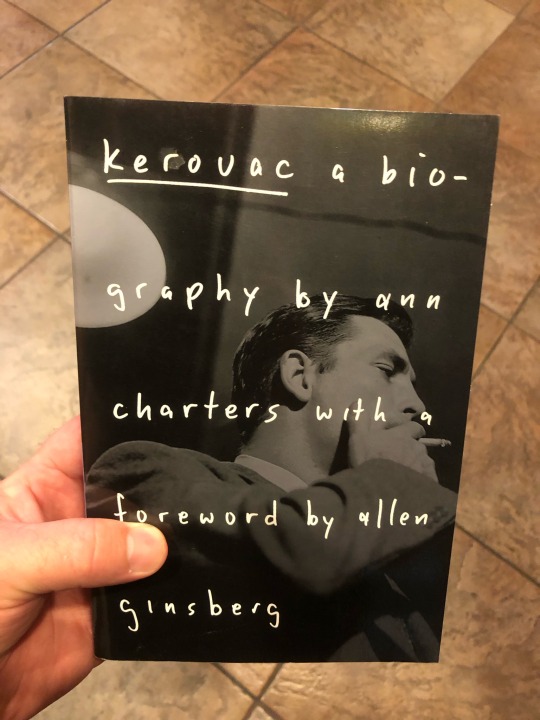
Day #4 - "Kerouac: A Biograpy" by Ann Charters
Although Jack Kerouac experimented sexually (with Neal Cassady, Gore Vidal, and others) he identified as heterosexual. Sorry! But he is queer adjacent!
Let's list some of the queer people you will meet in this book:
Allen Ginsberg (Gay)
William Burroughs (Bisexual)
Neal Cassady (Bisexual)
Gary Snyder (Bisexual)
Lucien Carr (Bisexual)
Herbert Huncke (Bisexual)
And more!
Jack was raised a strict Catholic, but was introduced to Zen Buddhism by Gary Snyer and became deeply interested in Buddhist teachings, practices, and meditation techniques, incorporating them into his daily life and shaping his spiritual outlook and writing style. Especially in his book "The Dharma Bums," Jack helped popularize Eastern philosophies and spiritual practices in the West, inspiring many to seek alternative paths to spirituality and personal fulfillment.
I'd say my two biggest influences on becoming a Buddhist was #1 Yoda and #2 Jack Kerouac.
And this is the best biography of Jack Kerouac I know of.
Tagging: @wernerherzoghaircut if you want to play along.
32 notes
·
View notes
Photo
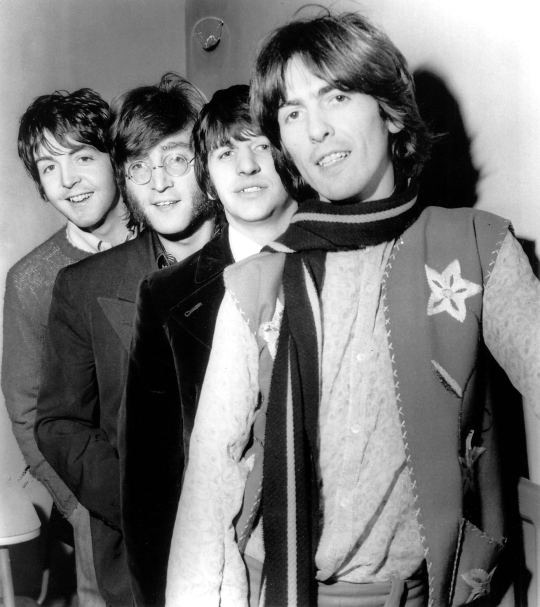
The Beatles, February 1968; photo: CEA/Cache Agency.
“Then there was the completely unpredictable influence of George Harrison. From the mid-sixties onwards, George took Beatles music along a road that had nothing whatsoever to do with his own background or culture, or with American music for that matter: he took it east. […] [George] soon gave a different cast entirely to the Beatles’ output, composing tracks that were about a light year away from their other songs. He added a whole new range of Indian instruments to the Beatles’ equation, instruments that crop up over and over in Beatles’ tracks throughout their career, and make their sound unlike anything anyone else has done before or since. George Harrison is a dark horse all right, a one-off. He marches to the sound of a different drum.” - George Martin, With A Little Help From My Friends: The Making of Sgt. Pepper (1994)
“Despite what I’ve said about the relatively marginal position that George’s music had within the group, it would be entirely wrong to think that he himself was excluded from it. George had something stronger than power: he had influence. Witness the fact that all of the boys followed him to India to sit at the feet of the Maharishi. George tried to persuade me to ease my karma, too, but I excused myself on the grounds of extreme old age.
The Beatles were all looking for something. They had achieved great fame and fortune, but that had made them wonder all the harder what it meant. They were looking for a greater faith than the half-baked versions of Eastern religion and culture circulating in the West could give them. They all wanted to experiment, to push at the envelope of their upbringing, beliefs and culture. They wanted to find out what it was all about.
George was able to answer some of the questions they asked, and the Maharishi seemed to answer more. He was able to bring them a measure of inner peace, which was something they had not found before.
Although they became disillusioned with it afterwards, transcendental meditation was more than a passing fad for the Beatles. […] The scales fell from their eyes when it became clear that the guru was after all very much a human being, with feet of clay, but George still to this day will insisted: ‘OK, that’s fair enough, but it doesn’t alter the basic truth,’ by which he means the truths he learned from Eastern philosophies all those years ago.” - ibid (x)
#George Harrison#George Martin#Paul McCartney#Ringo Starr#John Lennon#quote#quotes about George#The Beatles#George and fame#Harrison songwriting#Harrison spirituality#George and George Martin#1960s#Maharishi Mahesh Yogi#et al#fits queue like a glove
90 notes
·
View notes
Text
The Planets as Angels and Demons
In my tradition I work with planetary virtues by assigning them to days and hours in which certain works must be performed. As someone who also works in a Catholic context, I've assigned Angels and demons to embody the benefic and malefic aspects of these Planets. To me, an angel is not ruled by a planet, but is the planet itself. This is where anism comes into my practice. I acknowledge western occult classifications of angels and their planets, but I rework them to fit my own revelations instead of that according to old irrelevant wiccan men. That said, the 7 angels vs 7 demons lists across the world are heavily influenced by kabbalah. However my own list pulls from Greek Orthodox traditions and Philippino Catholic traditions based in Manila. I also allow the 3 books of occult philosophy to influence my worldview of these spirits and purposes. The 3 books of occult philosophy state that there is a benefic and malefic side to each planet. To copy this within my practice I assign one angel and one demon to a planet. I come to them not in ceremonial methods, but as folk saints.
The angels and their remedies are as followed:
Uriel- (sun/sunday) "regent of the sun" in folklore. He is known for being renowned, amiable, and acceptable; he adds potency in all good works, equaling a man to kings and princes, elevation to high fortunes, and success in all endeavors- I understand Michael as being the Sun in most traditions but I view micahel as being more war-minded and aligned with Mars. Uriel is historically referred to as regent of the sun and that should not be ignored.
Gabriel- (moon/monday) rendering the bearer grateful, amiable, pleasant, cheerful, and honored; removing malice and ill will, security during travel, increase of riches, bodily health, and the driving away of enemies and other evil things. - dreams, blessed pregnancy, prophecy of futures pertaining to spiritual paths and one's fate. Protector of families.
Michael-(mars/tuesday) potency in war, judgments, and petitions; victory against enemies, justice toward enemies for the sake of justice, not revenge. , and stopping of blood. Michael isncommonlynassociated with the color red and as mars is the" red planet" I saw it as fitting. Mars is described as our "sister planet" due to its similarities with earth. Given michael being so close and dear to humanity I saw this closeness and resemblance as representative of his love for us.
Raphael- (mercury/wednesday) rendering the bearer grateful and fortunate to do what they please, bringing gain, preventing poverty, and helping memory, understanding, and divination. He also encourages occult understanding through travel and reading signs given in nature. The protector of travelers and claims vengeance towards thieves.
Sealtiel- (jupiter/thursday) is often seen as the Patron Saint of prayer and worship for members of the Eastern Orthodox Church and some Catholic traditions. In some Orthodox traditions, he is said to help people interpret dreams, break addictions, protect children, preside over exorcisms, and rule over music in heaven. Orthodox Christians will seek his help if their prayer is suffering from distractions, inattentiveness, or coldness. In Catholic tradition, he is depicted with a thurible. He helps fight addiction, helps one seeking gains and riches, favor and love, peace, concord, appeasement of enemies, confirmation of honors, dignities, and counsels, and dissolving of enchantments. "The undoer of witchcraft" which is a title given to St Michael Archangel in traditions that don't recognize this angel.
Jehudiel- (venus/friday) ending concord, ending strife, procuring a woman's love traditionally but all genders apply. aiding in conception, working against barrenness, and causing spiritual abilities in a generation (or gifting a child with the power of prayer). also known for the dissolving of enchantments or lustful charms of a woman causing peace between men and women, making all kind of animals fruitful, protecting pets, curing melancholy, causing joyfulness, and bringing good fortune.
Barachiel-(saturn/saturday) the ability to bring forth, to make one safe, to make one's prayer powerful, and to cause a success of petitions with princes and powers. Marsilio Ficino and others also associated Saturn with intellectuals, whose minds are more lofty and divine than those of common folk. This is because Saturn is the highest planet in occult cosmology and therefore closest to God. this angel brings creativity, good study habits, focus, peace of mind and strengthens decision making skills to ensure good choices are made. -------
The Demons to be shared below are the traditional names of demons taken from Agrippa's 3 books of occult philosophy. It was common in older orthodox beliefs to associate the demons of the 7 deadly sins with the Planets, but I find the demons of the 7 deadly sins to be less influential and deadly than planetary powers would rival. Sin is on earth and changes as nature does. It's not written in the stars and predestined. Therefore, the 7 most well-known known demons on earth would not be fit to personify a planet. Expect a post on the 7 shortly.
After requesting the aide of these planetary demons, always cleanse the soul by prayer to the corresponding angel. Cursing another is similar to rolling in the mud yourself. Wash your hands as Caesar did. Without furthermore, here are the planetary demons that oppose these angels for matters of harming others:
Sorath(sun/sunday)- causing a man to be a tyrant, proud, ambitious, unsatisfiable, and to have an ill ending. Causes requested illness and can only be remedied by the corresponding angel.
Hasmodai- (moon/monday) rendering a location unfortunate and causing people to flee from it, hindering physicians, orators and all men whatsoever in their office. Blurs the psychic senses, hides works, ruins divination, curses divination tools to never work again.
Barzabel- (mars/Tuesday) hindering of buildings/homes, casting down the powerful from dignitaries, honors, and riches; causing discord, strife and hatred among men and beasts, chasing away bees, pigeons. and fish; hindering mills, rendering misfortune toward hunters and fighters, causing barrenness in men, women, and animals; striking terror into enemies, and compelling enemies to submit. Blighting of crops and all works money flows from.
Taphthartharath - (mercury/wednesday) rendering the bearer ungrateful and unfortunate in activities, encouraging poverty, driving away gains, and inhibiting memory, understanding, and divination. Steals spiritual gifts from others and gives them to the witch, can steal luck and good fortune of others. Hides the works of thieves, and protects stolen property from recovery.
Hismael- (jupiter/thursday) attract the baleful influences of Jupiter, of which Agrippa is curiously silent. However I am here with my own thoughts and experiences. This demon quite literally brings an end to the mind. It decays one's thoughts and happiness. It causes lunacy and mania. The hottest of the demons here.
Kedemel- (venus/friday) encouraging strife, driving away a woman's love, blocking conception, encouraging barrenness, blocking generational gifts and the blessing of ancestors, bringing bad luck, destroying joy, and encouraging melancholy. Ruins families, causes miscarriage, and attracts another's lover to you.
Zazel- (saturn/saturday) according to Agrippa includes the hindering of buildings and plantings i.e. growth, casting a man from honors and dignities, causing discord and quarrels, and dispersing armies. Turns one's men against him and creates jealousy. Ends the life of men.
Call on these spirits at your own risk. Always follow it with proper spiritual hygiene.
#folk witchcraft#traditional witchcraft#transgender witches#beginner witch#folk catholicism#animism#santa muerte#folkloric witchcraft#witchcraft#demons#demonology#angelology#grimoire
14 notes
·
View notes